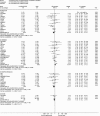Laparoscopic versus open appendectomy in children: a meta-analysis
- PMID: 16371732
- PMCID: PMC1449958
- DOI: 10.1097/01.sla.0000193602.74417.14
Laparoscopic versus open appendectomy in children: a meta-analysis
Abstract
Objective: This study aims to use meta-analysis to compare laparoscopic and open appendectomy in a pediatric population.
Summary background data: Meta-analysis is a statistical tool that can be used to evaluate the literature in both qualitative and quantitative ways, accounting for variations in characteristics that can influence overall estimate of outcomes of interest. Meta-analysis of laparoscopic versus open appendectomy in a pediatric population has not previously been performed.
Methods: Comparative studies published between 1992 and 2004 of laparoscopic versus open appendectomy in children were included. Endpoints were postoperative pyrexia, ileus, wound infection, intra-abdominal abscess formation, operative time, and postoperative hospital stay.
Results: Twenty-three studies including 6477 children (43% laparoscopic, 57% open) were included. Wound infection was significantly reduced with laparoscopic versus open appendectomy (1.5% versus 5%; odds ratio [OR] = 0.45, 95% confidence interval [CI], 0.27-0.75), as was ileus (1.3% versus 2.8%; OR = 0.5, 95% CI, 0.29-0.86). Intra-abdominal abscess formation was more common following laparoscopic surgery, although this was not statistically significant. Subgroup analysis of randomized trials did not reveal significant difference between the 2 techniques in any of the 4 complications. Operative time was not significantly longer in the laparoscopic group, and postoperative stay was significantly shorter (weighted mean difference, -0.48; 95% CI, -0.65 to -0.31). Sensitivity analysis identified lowest heterogeneity when only randomized studies were considered, followed by prospective, recent, and finally large studies.
Conclusions: The results of this meta-analysis suggest that laparoscopic appendectomy in children reduces complications. However, we also see the need for further high-quality randomized trials comparing the 2 techniques, matched not only for age and sex but also for obesity and severity of appendicitis.
Figures




Comment in
-
Re: Laparoscopic Versus Open Appendectomy in Children: A Meta-analysis.Ann Surg. 2008 Mar;247(3):555; author reply 555-6. doi: 10.1097/SLA.0b013e31816617a1. Ann Surg. 2008. PMID: 18376210 No abstract available.
References
-
- Fitz RH. Perforating inflammation of the vermiform appendix: with special reference to its early diagnosis and treatment. J Med Sci 1986;92:321–346.
-
- Semm K. Endoscopic appendectomy. Endoscopy. 1983;15:59–64. - PubMed
-
- Ortega AE, Hunter JG, Peters JH, et al. A prospective, randomized comparison of laparoscopic appendectomy with open appendectomy: Laparoscopic Appendectomy Study Group. Am J Surg. 1995;169:208–212. - PubMed
-
- Tang E, Ortega AE, Anthone GJ, et al. Intraabdominal abscesses following laparoscopic and open appendectomies. Surg Endosc. 1996;10:327–328. - PubMed
Publication types
MeSH terms
LinkOut - more resources
Full Text Sources
Medical

